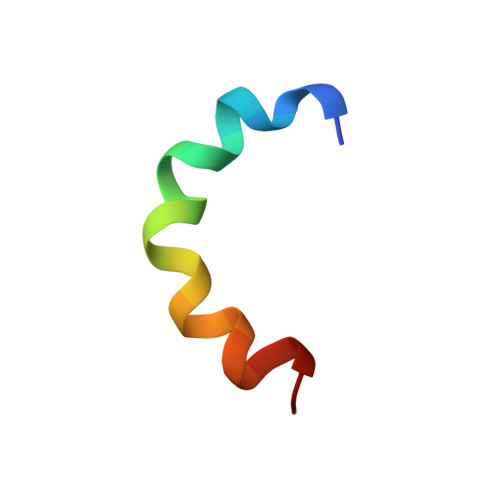Tryptophan end-tagging for promoted lipopolysaccharide interactions and anti-inflammatory effects.
Singh, S., Datta, A., Schmidtchen, A., Bhunia, A., Malmsten, M.(2017) Sci Rep 7: 212-212
- PubMed: 28303012
- DOI: https://doi.org/10.1038/s41598-017-00188-7
- Primary Citation of Related Structures:
2NCU, 2NCW - PubMed Abstract:
The objective of the present study is the investigation of possibilities for boosting peptide anti-inflammatory effects by tryptophan end-tagging, including identification of underlying mechanisms for this. In doing so, effects of tryptophan end-tagging of KYE21 (KYEITTIHNLFRKLTHRLFRR), a peptide derived from heparin co-factor II, on membrane and lipopolysaccharide (LPS) interactions were investigated by ellipsometry, NMR, fluorescence spectroscopy, and circular dichroism measurements. Through its N-terminal W stretch, WWWKYE21 displays higher membrane binding, liposome rupture, and bacterial killing than unmodified KYE21. Analogously, W-tagging promotes binding to E. coli LPS and to its endotoxic lipid A moiety. Furthermore, WWWKYE21 causes more stable peptide/LPS complexes than KYE21, as evidenced by detailed NMR studies, adopting a pronounced helical conformation, with a large hydrophobic surface at the N-terminus due to the presence of W-residues, and a flexible C-terminus due to presence of several positively charged arginine residues. Mirroring its increased affinity for LPS and lipid A, WWWKYE21 displays strongly increased anti-inflammatory effect due to a combination of direct lipid A binding, peptide-induced charge reversal of cell membranes for LPS scavenging, and peptide-induced fragmentation of LPS aggregates for improved phagocytosis. Importantly, potent anti-inflammatory effects were observed at low cell toxicity, demonstrated for both monocytes and erythrocytes.
Organizational Affiliation:
Department of Pharmacy, Uppsala University, SE-75232, Uppsala, Sweden. shalini.singh@farmaci.uu.se.














